|
Updated October 2012 What's Going on at Giacomini - in a Nutshell: Waterbird numbers continue to increase each year since restoration, particularly for dabbling ducks, with a record high number of approximately 11,488 waterbirds counted on one day in December 2010 (ARA 2012). However, shorebird numbers have been more variable. Numbers were low in the first winter after restoration, moderate in the second year and first half of the third year, and then declined sharply in the latter half of the third year (ARA 2012). In Year 4, shorebird numbers rebounded to approximately Year 2 levels (ARA 2012). Giacomini is still evolving as potential shorebird habitat, with this evolution strongly dependent on invertebrate prey bases in marsh muds. In the early years, the restored wetland primarily attracted species that forage in the water column, ground, and in shallow sediments (J. Evens, ARA, pers. comm.), however, starting with the increase in numbers since fall 2011 of Marbled godwits and Dowitchers, which forage more deeply in muds, this may be yet another confirmation of what we have observed through our benthic invertebrate and zooplankton monitoring results--numbers of benthic invertebrates in the restored wetlands are climbing dramatically, and species composition is shifting. See Untangling the Food Web: Changes in Prey Base Following Restoration. Click on a link below to read more about Giacomini Wetlands: A Haven for Ducks: 2012 Update. Introduction Read Giacomini Wetlands: A Haven for Ducks - 2011 Update and Not Just for Ducks Anymore--the February 2010 update--for more in-depth information about waterfowl in the Giacomini Wetlands before restoration and during the first three years after restoration. 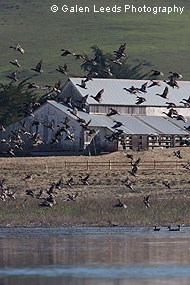
Introduction Perhaps, the most visible evidence of the early success of restoration efforts at Giacomini can be seen during the fall and winter, when thousands of birds are scattered across the shimmering expanse of blue. On a still day, the air reverberates with the sounds of flapping wings, splashing water, and the low hum/drone of chattering birds. The water that blankets the newly restored Giacomini Wetlands during the migratory season results in an explosion in waterbird numbers each fall and winter, and the numbers of these migratory converts continue to grow substantially each year. Numbers of waterbirds, particularly waterfowl, in Year Three greatly exceed that of Years Two and One, although shorebird numbers have varied dramatically since the levees were breached. Tidal wetlands in the greater San Francisco Bay area region provide especially valuable habitat for migrating and wintering waterbirds (Shuford et al. 1989; Goals Project 2000 in ARA 2010), and Tomales Bay is part of a network of Bay Area coastal estuaries that support waterbird populations of hemispheric importance (Kelly 2001). Fall is a period of avian movement and migration, the transition of species between nesting territories and wintering grounds (ARA 2009). Overall waterbird use tends to be low in the fall, but migratory flocks "stop-over" to forage for brief periods before moving on (ARA 2009). As one of the key coastal wetland stepping stones for migrating shorebirds along the Pacific coast, Tomales Bay provides a crucial stopover feeding habitat (Kelly and Condeso 2009). Individuals may stay only a few days to refuel before moving on, or they may stay longer (ibid). During fall migration, first year birds select wintering areas they will to return to in subsequent years (ibid). Little is known about this selection process, but most of them will probably make this choice by mid-November (ibid). Before restoration, bird use of Giacomini was seasonally sporadic and rather limited. Pastures were used for roosting by Canada geese, Great blue herons, Great egrets, and mallards and nesting by grassland species such as Song and Savannah sparrows (ARA et al. 2002). The limited number of water features left in the dairy such as ditches and managed creeks also supported low numbers of Mallards, Gadwall, Lesser scaup, and Eared grebes (ARA et al. 2002). Occasionally, diving ducks such as Buffleheads used some of the old Duck Ponds created by the Giacominis for hunting (ARA et al. 2002). During the winter and spring, bird use would climb dramatically, with sustained flooding of lower elevation areas in the northeastern corner of the East Pasture, known as the Shallow Shorebird area. Dabbling ducks such as Gadwall, American wigeon, and Green-winged Teal stopped here, but the highest use probably came from shorebirds that would roost and forage here when tides were high in Tomales Bay (ARA et al. 2002). The most common shorebird visitors were Dunlin, Dowitcher, Greater yellowlegs, Common snipe, Willet and Killdeer (J. Kelly, ACR, pers. comm.). With restoration, waterfowl use of the Project Area was projected to remain similar to historic levels or increase slightly, while shorebird use was predicted to increase more dramatically (NPS 2007). As the marsh had subsided--or dropped in elevation very little since first being leveed in the 1940s--the former dairy ranch was expected to convert relatively quickly to a marsh very similar to the one directly north of Giacomini, near Inverness. This tidal marsh is predominantly marshplain with an intricate network of intertidal tidal creeks. This type of habitat would have great value for foraging shorebirds, but, without large ponds or open water areas, ducks would not find the restored marsh that attractive. Also, with conversion of pastures to marsh, numbers of grassland-associated species were expected to suffer the largest decline (NPS 2007). What actually happened astonished all. 
Post-Restoration Less than two months after the levees were breached, enormous flocks of waterfowl descended on the waters of the newly restored Giacomini Ranch. In December 2008, more than 3,295 waterbirds were counted during one morning survey (ARA 2011). Approximately 5,552 individuals and 44 different waterbird species were observed in 2008-2009, of which more than 90 percent were waterfowl species (ibid). The density of birds during this season averaged 8.1 per hectare (ibid). During that first winter, some of the species with the highest numbers were American wigeon (47%), Northern pintail (25%), Green-winged teal (6%), and Northern shoveler (3%). Other duck species included Gadwall, Mallard, Cinnamon teal, Bufflehead, and Ruddy duck. 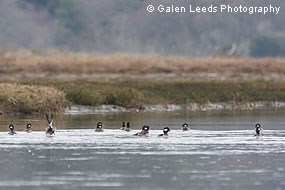
The number of waterbirds has continued to climb dramatically each year after restoration. The restored wetland attracted incredibly high number of waterbirds in Years Two, Three, and Four, with the total number of birds observed climbing from 34,084 in 2010-2011 to 58,892 in 2011-2012, a 73% increase (ARA 2012). While waterbird abundance has typically peaked in December, in Year 4, it actually peaked in January, with a new high of 11,709 individuals (ARA 2012). December numbers were also high, with a peak count of 11,125 observations on December 16, 2011 (ibid). Species richness also continued to rise slightly from 64 in Year Two to 74 in Year Three and 75 in Year Four (ibid). Average number of birds per survey climbed dramatically from 3,408.4 in 2010-2011 to 6,543.6 in 2011-2012, with one less survey actually conducted in Year Four (ibid). 
Waterfowl Similar to previous years, waterbird composition was again dominated by waterfowl, although the percentage dropped slightly relative to Year Three (ARA 2012). In Year Ones and Three, waterfowl accounted for a preponderance of the waterbirds, ranging from 93.3 in Year One to 89.8 in Year Three (ibid). In Years Two and Four, those percentages dropped substantially to approximately 72% in both years (ibid). Surface-feeding waterfowl species dominate the wintering avian community (ibid). Bufflehead has been the only diving duck species that has occurred in any notable abundance, increasing in Year Four (ibid). Interestingly, the mean abundances of dabbling ducks at the newly restored wetlands in since the levees were breached has greatly exceeded any of the mean values reported by Kelly and Tappen in 1998 for all of Tomales Bay (ibid). 
Since at least Year Two, American wigeon has represented the dominant species, accounting for at least 5% of the approximately 43,815 ducks counted. Ranked roughly in descending order, other dominant species included Green-winged teal, Northern pintail, and, depending on the year, either Gadwall or Northern shoveler (ibid). While peak pre-restoration densities are not readily available in the U.S. Geological Survey monitoring effort that was conducted prior to restoration to evaluate bird use of the unrestored dairy ranch, some conclusions about the effect of restoration can be made regarding mean densities of certain species (ARA 2011). Prior to restoration, dabblers such as American coot, American wigeon, and Northern pintail had the highest mean density per hectare of 6 per ha in the East Pasture (after American blackbirds; ARA 2011). Averaged for the entire Project Area, dabbler density dropped slightly to 4 birds/ha (ibid). 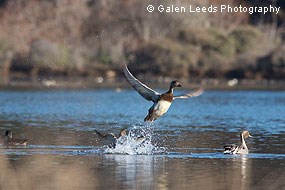
Peak densities of American wigeon, Green-winged teal, and Gadwall have climbed substantially since the ranching period (R2 between 0.38 to 0.90), although relative abundance has varied from year-to-year (ibid). In Year Three post-restoration, the same suite of six dabbling duck species--American wigeon, Gadwall, Green winged-teal, Northern pintail, Northern shoveler, and Mallard--averaged 12.8 birds/hectare, an increase of 320% (ibid). By Year Four, American wigeon had increased ten-fold from pre-restoration numbers, with Year 4 abundance being 60 percent higher than Year Three (ibid). Green-winged teal numbers increased three-fold from Year Three to Year Four (ibid). Mallard was the only species that actually showed a decrease in numbers relative to pre-restoration abundance (ARA 2011). Interestingly, while these species have remained the dominant ones, the dominance of these five species, however, has decreased steadily over time, dropping from 82.3% of the total in Year One to 58.2% of the total in Year Four. 
American coots are not typically categorized as a waterfowl or shorebird, but are considered a unique species with a variety of foraging habitats. During Year Four, exceptional numbers of coots visited the restored wetlands, averaging 645.6 coots per census with a peak count of 2,000 on December 16, 2011 (ARA 2012). The high numbers mirrored a region-wide population "bump" in the winter of 2011-2012 (ARA 2012). 
Shorebirds The potential value of the restored wetland for shorebirds, as well as waterfowl, must have seemed promising when a flock of dunlins flew into the wetlands on the day the final levee was breached. In early November 2008 surveys, shortly after breaching of levees, monitors from ACR observed some Short-billed and Long-billed dowitchers and scattered groups of Western and Least sandpipers in the newly restored marsh, Kelly said. Evens noted at least 1,000 Least and Western sandpipers around the edges of the flooded marsh in early November 2008 (Evens, pers. comm.). However, despite these early promising signs, numbers of shorebirds during the first winter was very low (ARA 2011, Kelly and Condeso 2011), accounting for less than 1% of all waterbirds observed by ARA during its surveys. Most of these species observed were Greater yellowlegs, Wilson's snipe, Killdeer, and Least sandpiper (Kelly and Condeso, unpub. data). Although shorebird use remained low during the first year after restoration relative to established feeding areas in Tomales Bay, shorebird abundance within the restoration area did seem to increase a bit in the late winter of the first year, though species composition remained similar (E. Condeso, pers. comm.). Later, during the peak migratory season for shorebirds in spring, shorebird numbers increased slightly yet again (ARA 2011, Kelly and Condeso 2011, although dabbling ducks still accounted for 84% of the waterbirds observed (ARA 2011). Though the distributions of shorebirds varied among counts, most of the shorebirds observed occurred in specific areas, including the East Giacomini Marsh (Shallow Shorebird Area in northern portion of East Pasture), the goby pond in the northern portion of the East Pasture, and the Triangle Marsh Area (Tomasini Triangle Marsh in central portion of East Pasture; Kelly and Condeso, unpub. data). These ponded areas of the newly restored Giacomini Wetland provide habitat that seems suitable for a number of species (E. Condeso, pers. comm.). 
Wader abundance climbed dramatically in Year Two, with the ACR August 2009 count totaling nearly three times as many birds as the highest winter 2008-2009 estimate (Kelly and Condeso 2009). This increase in numbers during the August survey was mostly due to a spike in the number of Least sandpipers observed (ibid). In addition to the species seen during the winter of 2008-2009, Western sandpipers, Dunlin, and Willets were also observed in spring and fall by ACR (ibid). Dunlins, which are the most abundant shorebird in Tomales Bay, did not visit the restored wetlands until Year Two (Kelly and Condeso 2011). Dowitchers were recorded in respectable numbers--66 for Short-billed and 5 for Long-billed--for the first time in fall 2009 (ibid). Some of the increases in abundance, density, and species richness in Year Two may have been due to the greater number of surveys conducted in Year Two, as official surveys doubled from three to six, however, the average number of birds per survey also climbed from 1,850.7 in 2008-2009 to 2,917.8 in 2009-2010, suggesting that increases were not just an aberration of a change in survey approach. Wader abundance continued to increase during the winter of Year Two (ARA 2010). Abundance of shorebirds increased 25-fold from 87 individuals in December and January of Year One to 2,221 individuals in December and January of Year Two (ARA 2011). On the first two surveys, shorebirds accounted for 26 to 29 percent of all waterbirds detected, a substantial increase from 2008-2009, when shorebirds represented less than 1 percent of birds observed (ibid). In addition to the expected increase in small calidrine sandpipers (Least sandpipers and Dunlin), high numbers of Dowitchers and Yellowlegs were present (ibid). Some shorebirds occurred in very high numbers during December 2010: Greater yellowlegs peaked at 79 individuals, and Dowitchers (probably Long-billed) climbed as high as 580 birds (ibid). Based on numbers from Kelly (2001), these numbers appeared exceptional for Tomales Bay. In addition, the 500 Red-necked phalaropes that flocked in the northern portion of the East Pasture in "Goby pond" also represented a new high number for this species in this region based on data from Shuford et al. (1989) and Kelly (2001; ARA 2011). As with waterfowl, wader numbers started dropping in January and continued to decrease through April, with very few shorebirds present in spring 2010, although they represented an overwhelming majority (86.5%) of the birds present (ibid). Mid-winter decreases in waterbirds associated with cumulative seasonal rainfall is common in Tomales Bay (Kelly and Tappen 1998, Kelly 2001) and other coastal estuaries (Colwell 1983, Shuford et al. 1989, Warnock et al. 1995 in ARA 2010, 2011). This seasonal decline may be associated with a shift to other now-flooded habitat such as pastures or shallow inland basins or with a seasonal shift in foraging patterns and prey availability (ARA 2010). In post-restoration monitoring, waterbird use of Giacomini Wetlands clearly declined by as much as approximately 63 to 73 percent in Years Two and Three, respectively, starting in late winter or January, typically when the heaviest rainfalls begin (ARA 2011). Interestingly, Black-bellied plover numbers remained remarkably equivalent throughout the early winter surveys, suggesting that this species may have resided at Giacomini during that winter (ibid). 
With such promising results in Year Two, great things were expected in Year Three relative to continued increases in shorebird abundance. By 2009-2010, waders appeared to have "found" the newly restored wetlands. At first, all appeared to be on track for another record-breaking shorebird year, as numbers were high through through fall and early winter of Year Three (Kelly and Condeso 2011). However, in mid- and late- winter and spring, wader numbers plummeted relative to the previous year (ARA 2011, Kelly and Condeso 2011; Figure 3 [29 KB PDF]). For all ARA surveys combined in Year Three, waders represented only 5.7% of the waterbird community, compared to an average of 27.1% during Year Two (ARA 2011). In addition, waders averaged only 327.3 individuals/survey in Year Three, compared to 780.7 individuals/survey in Year Two (ARA 2011). On at least one count date in Year Three (11/12/10), shorebirds did account for 20.5% of all waterbirds observed (ARA 2011). This peak number illustrated one of the confounding variables of any biological or environmental monitoring efforts: surveys or sampling may not always catch peak abundance or concentrations. Most of ARA's survey effort was concentrated in mid- to late winter and spring, so, therefore, averages were skewed by the scarcity of waders during that period. However, this phenomenon was not relegated strictly to Giacomini. Reduced abundances of shorebirds occurred throughout Tomales Bay in late winter and spring of 2010-2011 (Kelly and Condeso 2011). Some of this may be due again to increased precipitation during those periods, as discussed earlier: The decline in numbers corresponds closely to the onset of rainy season (Figure 3 [29 KB PDF]). Also, use of coastal estuaries is typically lower in wet years than dry years (ARA 2011). Despite reduced shorebird numbers overall in Year Three, some species continued to persist at the newly restored wetlands, including Greater yellowlegs, which had a peak abundance in Year Three of 82 individuals, roughly equivalent to Year Two (79 individuals; ARA 2011), although ACR surveys suggested a stronger decrease relative to Year Two (Kelly and Condeso 2011). Greater yellowlegs have always visited southern Tomales Bay in high numbers, leading some birders to consider it "magic" for this long-legged species (Kelly and Condeso 2011). 
Western sandpiper occurred in incredibly high numbers during Fall 2010 (mean of >800): juvenile fall migrant often determine wintering areas for future years (Kelly and Condeso 2011). Least sandpipers also returned in early winter of Year Three in roughly equivalent numbers to the prior year (Kelly and Condeso 2011). Wilson's snipe was one of the few species that remained relatively common in Year Three during both early winter and late winter surveys (Kelly and Condeso 2011). This species has always been attracted to the seasonally inundated or saturated grassy margins of the Project Area (Kelly and Condeso 2011). Conversely, numbers of species such as Dunlin (the most common shorebird in Tomales Bay), Black-bellied plovers, Dunlin, and Dowitchers fell dramatically during Year Three. Ironically, in Year Four, this decline in shorebird abundance reversed again. Numbers of waders in Year Four more closely resembled those of Year Two, with numbers much higher than Year Three (ARA 2012). Shorebirds accounted or 26.8% of all waterbirds in Year 4, compared to only 9.6% in Year Three; 23.2% in Year Two; and 3.7% in Year One (ibid). Least sandpiper, a small shorebird that feeds primarily on the marsh surface, represented about two-thirds or 63% of all waders similar to previous years (ibid). However, Year Four was marked by an increase in use by long-legged waders, particularly Marbled godwits and Dowitchers (ibid). Although Dowitchers showed a significant presence also in Year Two, Marbled godwits did not arrive at the restored wetland in any large numbers until Year Four, with a high count of 241 on January 26, 2012. A migrant flock of American avocet also dropped in during the fall of Year Four: this species had never sighted here before and is relatively rare on Tomales Bay (ibid). Both Marbled godwits and Dowitchers were observed roosting and actively foraging in the Giacomini Wetlands. This is notable, because both species are long-billed and forage by probing the substrate. One of the reasons that wader colonization of the restored wetland may have lagged behind that of waterfowl is that many shorebird species might require development of an adequate benthic invertebrate prey base. With these areas formerly being pastures, they obviously did not support many benthic invertebrates, and even the diked channels had only few and relatively monotypic benthic invertebrate communities (Parsons and Sanders, in prep.). Studies from southern California showed that polychaetes represented one of the most important fall food items for Marbled godwits, followed by bivalves in the winter, and crabs and bivalves in the spring (Recher 1966, Stenzel et al. 1983, Ramer et al. 1991 in Gratto-Trevor 2000). Dowitchers in the San Francisco Bay area commonly foraged on sedentary polychaetes (Capitella), amphipods (Corophium), and bivalves (Gemma sp., Macoma sp., etc.; Stenzel et al. 1983; Takekawa and Warnock 2000). All of these taxa have been documented within the restored wetland (Parsons et al., in prep.). After restoration, the three most common taxonomic groups in the restored dairy ranch were Oligochaeta (30%), non-native Paracorophium (Amphipoda; 27%), and non-native M. insidiosum (Amphipoda; 16%; ibid). In comparison, in the natural marshes, the most common taxonomic groups were Nematoda (33%) and Paracorophium (16%), with Oligochaeta, S. benedicti (Polychaete), non-native Pygospio elegans (Polychaete), and M. insidiosum representing an additional 36% of the species present (ibid). The native amphipod Eogammarus confervicolus appeared to be present in much higher numbers in post-restoration Giacomini than natural marshes (ibid). Conversely, Reference Areas still had higher numbers of G. gemma, S. benedicti, and Allorchestes, than the restored dairy ranch. Polychaetes--which, in general, have been associated with newly restored systems--comprised very little of the invertebrate assemblage at Giacomini and the adjacent Undiked Marsh either pre- or post-restoration, with oligochaetes being more predominant both pre-and post-restoration at Giacomini and the Undiked Marsh (ibid). Polychaetes accounted for more of the benthic invertebrate community at Limantour Marsh and Walker Creek Marsh both pre- and post-restoration, although, in general, nematodes were numerically dominant (ibid). The abundance of amphipods jumped dramatically at Giacomini post-restoration, as well as in the Undiked Marsh downstream of Giacomini, with Amphipoda being the numerically dominant taxonomic order in these systems (ibid). For more information, see See Untangling the Food Web: Changes in Prey Base Following Restoration. 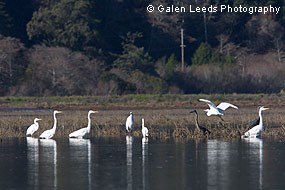
Other Species Different types of species also started visiting the newly restored wetland. Of the 41 waterbird species observed by ARA in fall 2009, 20 species or approximately 38 percent of species were only observed during one census, with approximately 11 of the 20 species or 21 percent of the total represented by observation of only one individual (ARA 2009). Some of these individual sightings represented firsts for the Giacomini Wetlands since breaching of the levees in 2008, including American golden-plover, Solitary sandpiper, and Pectoral sandpiper (ARA 2009). 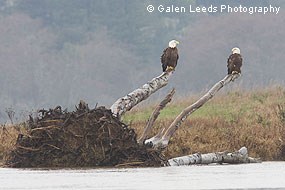
Other species of note during the latter half of Year One and Year Two included Merlin, Long-billed curlew, Green heron, as well as non-waterbird species such as Bald eagles and Peregrine falcon (Falco peregrinus pealii) of the northern race (Kelly and Condeso 2009). Adults and immature Bald eagles, which were once extremely rare in west Marin, started visiting the site in spring 2009 and have remained occasional visitors to the wetlands, with at least four different individuals observed (ARA 2009). 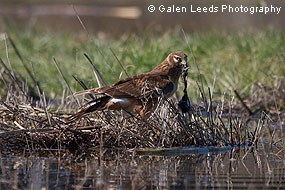
Some of the new noteworthy additions to the restored wetlands during Year Three included Redhead, Eared grebe, Clark's grebe, Lesser yellowlegs, and Heerman's gull (ibid). Two species also "flew over" the site, but did not drop in--Surf scoter and Wandering tattler (ibid). A rare Yellow rail was also apparently detected in the newly restored West Pasture near Inverness Park during the Christmas bird count (K. Hansen, T. Easterla in ARA 2011). This species has been observed in the Undiked Marsh north of Giacomini in previous years, but never within the former dairy site (ibid). Conclusions As with all biological species, increases and decreases from year-to-year cannot be evaluated without considering all the other potential factors that could affect these animals, such as climatic variation, impacts to non-wintering and other habitat, disease, and natural population dynamics or cycles. Bird use of the newly restored wetlands is dependent on a number of factors, including migratory birds finding the site and the site providing what the birds need to eat. The taxa observed so far have a wide range of dietary needs, from species that largely consume seeds and other plant matter to those such as Greater yellowlegs who eat fish and other aquatic prey. Most of the waterfowl have been dabbling ones, with bufflehead being the only diving duck occurring in any numbers (ARA 2012). In terms of shorebirds, the species that showed up during the early years were species that forage on the surface (e,g., Black-bellied plovers), shallow probers (e.g., Least sandpipers), and those that forage in the shallow water column (e.g., Greater yellowlegs; J. Evens, ARA, pers. comm.). However, by Year Four, two long-billed species that probe more deeply in the mud became more abundant: Marbled godwit and Dowitchers (ARA 2012), Analysis of benthic invertebrate data suggests that numbers of benthic invertebrates within the restored wetlands are increasing and becoming more diverse, and this is perhaps borne out by higher abundance in recent years of deeper substrate probers (ARA 2012). We are continuning to analyze changes in the zooplankton, benthic invertebrate, and fish communities in hopes of understanding how the prey base for many target organisms is changing with restoration. To evaluate how much of an effect the restoration itself might be having on higher bird numbers in southern Tomales Bay, Kelly and Condeso (2011) conducted an analysis to adjust shorebird abundances to take into account inter-annual variation observed for these species in other areas of Tomales Bay. What they found was that overall shorebird numbers in Tomales Bay closely match what might have been predicted even without restoration (Kelly and Condeso 2011). However, abundances of particular shorebird species did appear to be higher than would be predicted without restoration, including numbers of Least sandpiper, Western sandpiper, Dowitchers, Black-bellied plovers, and Greater yellowlegs (Kelly and Condeso 2011). Read the accompanying article, "The effects of large-scale restoration on regional shorebird use: just because you built it, does it necessarily mean that they will come?" for more detail on the results. In general, then, despite a somewhat uneven start for shorebirds, the restoration is supporting higher numbers of birds after restoration (ARA 2012, Kelly and Condeso 2011). The future for bird use ultimately will depend on both extrinsic factors and intrinsic ones, including the trajectory taken by the marsh in its continued evolution, both from a physical and biological standpoint. -- Content for these pages was composed by Lorraine Parsons, Project Manager, Giacomini Wetland Restoration Project, Point Reyes National Seashore Special thanks to Galen Leed Photography for the wonderful photos! Read Audubon Canyon Ranch's report "Shorebird Use of the Giacomini Wetlands Restoration area: 2011 Update." to learn more about the shorebird changes! (903 KB PDF) Citations Avocet Research Associates (ARA; 2002). Giacomini Wetland Restoration Site: special status animal species - reconnaissance and compliance, Final report to Point Reyes National Seashore, National Park Service. Avocet Research Associates (ARA; 2009). Tomales Bay Wetland Restoration Site. Final report to Point Reyes National Seashore, National Park Service. Avocet Research Associates (ARA; 2010). Tomales Bay Wetland Restoration Site Winter Avian Surveys, Years 1 & 2: Interim report to Point Reyes National Seashore, National Park Service. Avocet Research Associates (ARA; 2011). Giacomini Marsh Wetland Restoration Avian Population Surveys: Winter 2008-2011. Final report to Point Reyes National Seashore, National Park Service. Avocet Research Associates (ARA; 2012). Giacomini Marsh Wetland Restoration Avian Population Surveys: Post-Restoration Avian Population Surveys. Winter Season Year-4 2011-2012. Final report to Point Reyes National Seashore, National Park Service. Colwell, M.A. 1983. Shorebird community patterns in seasonally dynamic estuary. Condor. 95:104-114. Goals Project. 2000. Baylands Ecosystem Species and Community Profiles: life histories and environmental requirements of key plants, fish, and wildlife. Prepared for the San Francisco Bay Area Wetlands Ecosystem Goals Project. P.R. Olofson, editor. San Francisco Regional Water Quality Control Board, Oakland, California. San Francisco Bay Estuary. Gratto-Trevor, C.L. 2000. Marbled godwit (Limosa fedoa), The Birds of North America Online (A. Poole, Ed.). Ithaca: Cornell Lab of Ornithology. Kelly, J.P. and S.L. Tappen. 1998. Distribution, abundance, and implications for conservation of winter waterbirds on Tomales Bay, California. Western Birds: 29:103-120. Kelly, J. and E. Condeso. 2009. Update on Shorebird Use of Newly Restored Wetlands. Prepared for Point Reyes National Seashore. Parsons, L., L. Sanders, and A. Ryan. in prep. Changes in the food web linked to restoration effort intensity and watershed conditions. Ramer, B. A., G. W. Page, and M. M. Yoklavich. 1991. Seasonal abundance, habitat use, and diet of shorebirds in Elkhorn slough, California. West. Birds 22:157-174. Recher, H. F. 1966. Some aspects of the ecology of migrant shorebirds. Ecology 47:393-407. Shuford, W.D., G.W. Page, J.G. Evens, and L.E. Stenzel. 1989. Seasonal abundance of waterbirds at Point Reyes: a California perspective. Western Birds. 20:137-265. Stenzel, L. E., G. W. Page, and S. Young. 1983. The trophic relationships between shorebirds and their prey. Point Reyes Bird Observatory, Stinson Beach, CA. Takekawa, J.Y. and N. Warnock. 2000. Long-billed Dowitcher (Limnodromus scolopaceus). The Birds of North America Online (A. Poole, Ed.). Ithaca: Cornell Lab of Ornithology. Warnock, N. , G.W. Page, and L.E. Stenzel. 1995. Non-migratory movements of Dunlin on their California wintering grounds, Wilson Bulletin. 107:131-139. |
Last updated: June 27, 2024
